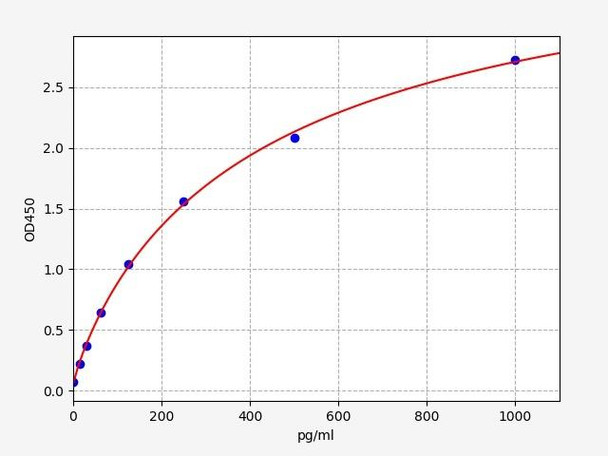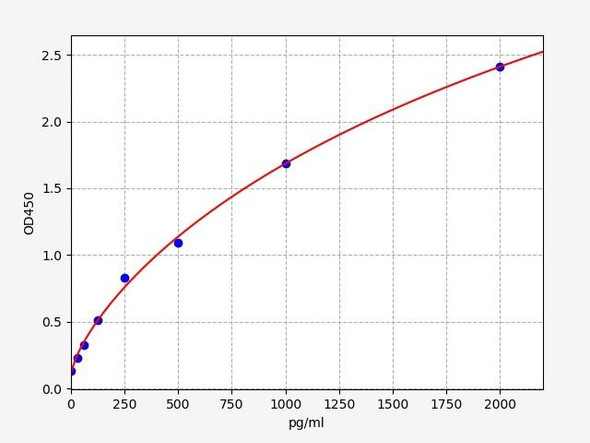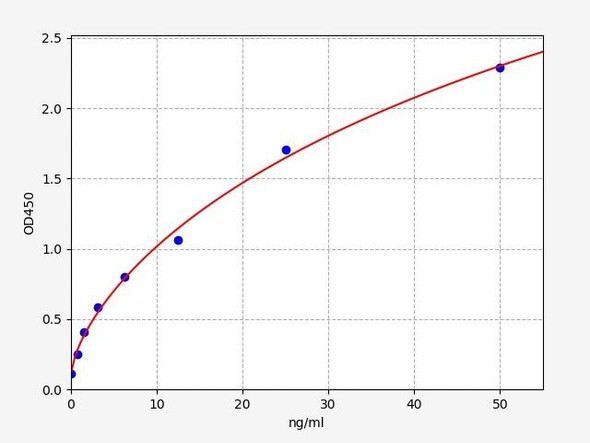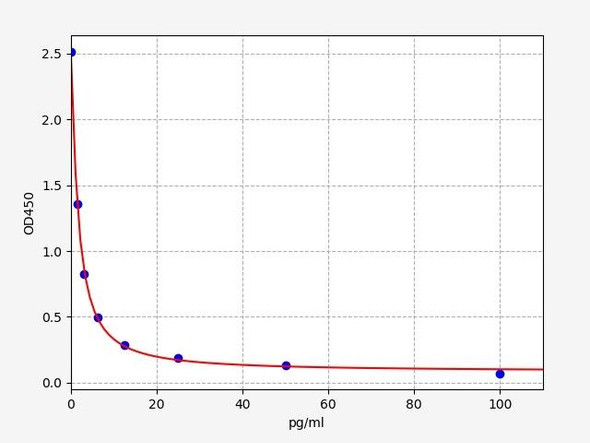Human UHRF1 ELISA Kit (HUFI05798)
- SKU:
- HUFI05798
- Product Type:
- ELISA Kit
- Size:
- 96 Assays
- Uniprot:
- Q96T88
- Sensitivity:
- 9.375pg/ml
- Range:
- 15.625-1000pg/ml
- ELISA Type:
- Sandwich ELISA, Double Antibody
- Synonyms:
- hNP95, HuNp95, ICBP90, Nuclear protein 95, RING finger protein 106, RNF106, Transcription factor ICBP90, UHRF1
- Reactivity:
- Human
Description
| Product Name: | Human UHRF1 ELISA Kit |
| Product Code: | HUFI05798 |
| Size: | 96 Assays |
| Alias: | hNP95 ELISA Kit, HuNp95 ELISA Kit, ICBP90 ELISA Kit, Nuclear protein 95 ELISA Kit, RING finger protein 106 ELISA Kit, RNF106 ELISA Kit, Transcription factor ICBP90 ELISA Kit, UHRF1 ELISA Kit |
| Detection method: | Sandwich ELISA, Double Antibody |
| Application: | This immunoassay kit allows for the in vitro quantitative determination of Human UHRF1 concentrations in serum plasma and other biological fluids. |
| Sensitivity: | < 9.375pg/ml |
| Range: | 15.625-1000pg/ml |
| Storage: | 4°C for 6 months |
| Note: | For Research Use Only |
| Recovery: | Matrices listed below were spiked with certain level of Human UHRF1 and the recovery rates were calculated by comparing the measured value to the expected amount of Human UHRF1 in samples. Enquire for more information. |
| Linearity: | The linearity of the kit was assayed by testing samples spiked with appropriate concentration of Human UHRF1 and their serial dilutions. The results were demonstrated by the percentage of calculated concentration to the expected. Enquire for more information. |
| CV(%): | Intra-Assay: CV<8% Inter-Assay: CV<10% |
| Component | Quantity | Storage |
| ELISA Microplate (Dismountable) | 8×12 strips | 4°C for 6 months |
| Lyophilized Standard | 2 | 4°C/-20°C |
| Sample/Standard Dilution Buffer | 20ml | 4°C |
| Biotin-labeled Antibody(Concentrated) | 120ul | 4°C (Protect from light) |
| Antibody Dilution Buffer | 10ml | 4°C |
| HRP-Streptavidin Conjugate(SABC) | 120ul | 4°C (Protect from light) |
| SABC Dilution Buffer | 10ml | 4°C |
| TMB Substrate | 10ml | 4°C (Protect from light) |
| Stop Solution | 10ml | 4°C |
| Wash Buffer(25X) | 30ml | 4°C |
| Plate Sealer | 5 | - |
Other materials and equipment required:
- Microplate reader with 450 nm wavelength filter
- Multichannel Pipette, Pipette, microcentrifuge tubes and disposable pipette tips
- Incubator
- Deionized or distilled water
- Absorbent paper
- Buffer resevoir
| UniProt Protein Function: | UHRF1: Multidomain protein that acts as a key epigenetic regulator by bridging DNA methylation and chromatin modification. Specifically recognizes and binds hemimethylated DNA at replication forks via its YDG domain and recruits DNMT1 methyltransferase to ensure faithful propagation of the DNA methylation patterns through DNA replication. In addition to its role in maintenance of DNA methylation, also plays a key role in chromatin modification: through its tudor-like regions and PHD- type zinc fingers, specifically recognizes and binds histone H3 trimethylated at 'Lys-9' (H3K9me3) and unmethylated at 'Arg-2' (H3R2me0), respectively, and recruits chromatin proteins. Enriched in pericentric heterochromatin where it recruits different chromatin modifiers required for this chromatin replication. Also localizes to euchromatic regions where it negatively regulates transcription possibly by impacting DNA methylation and histone modifications. Has E3 ubiquitin-protein ligase activity by mediating the ubiquitination of target proteins such as histone H3 and PML. It is still unclear how E3 ubiquitin-protein ligase activity is related to its role in chromatin in vivo. May be involved in DNA repair. Defects in UHRF1 may be a cause of cancers. Overexpressed in many different forms of human cancers, including bladder, breast, cervical, colorectal and prostate cancers, as well as pancreatic adenocarcinomas, rhabdomyosarcomas and gliomas. Plays an important role in the correlation of histone modification and gene silencing in cancer progression. Expression is associated with a poor prognosis in patients with various cancers, suggesting that it participates in cancer progression. 2 isoforms of the human protein are produced by alternative splicing. |
| UniProt Protein Details: | Protein type:DNA-binding; Ligase; Ubiquitin conjugating system; Ubiquitin ligase; EC 6.3.2.-; EC 6.3.2.19; Transcription factor Chromosomal Location of Human Ortholog: 19p13.3 Cellular Component: euchromatin; heterochromatin; nuclear chromatin; nuclear heterochromatin; nuclear matrix; nucleus; replication fork Molecular Function:histone binding; identical protein binding; methyl-CpG binding; methylated histone residue binding; nucleosomal histone binding; protein binding; transcription factor activity; ubiquitin-protein ligase activity; zinc ion binding Biological Process: cell proliferation; histone monoubiquitination; histone ubiquitination; maintenance of DNA methylation; negative regulation of transcription from RNA polymerase II promoter; positive regulation of cellular protein metabolic process; positive regulation of transcription from RNA polymerase II promoter; protein autoubiquitination; protein ubiquitination during ubiquitin-dependent protein catabolic process |
| NCBI Summary: | This gene encodes a member of a subfamily of RING-finger type E3 ubiquitin ligases. The protein binds to specific DNA sequences, and recruits a histone deacetylase to regulate gene expression. Its expression peaks at late G1 phase and continues during G2 and M phases of the cell cycle. It plays a major role in the G1/S transition by regulating topoisomerase IIalpha and retinoblastoma gene expression, and functions in the p53-dependent DNA damage checkpoint. It is regarded as a hub protein for the integration of epigenetic information. This gene is up-regulated in various cancers, and it is therefore considered to be a therapeutic target. Multiple transcript variants encoding different isoforms have been found for this gene. A related pseudogene exists on chromosome 12. [provided by RefSeq, Feb 2014] |
| UniProt Code: | Q96T88 |
| NCBI GenInfo Identifier: | 67462077 |
| NCBI Gene ID: | 29128 |
| NCBI Accession: | Q96T88.1 |
| UniProt Secondary Accession: | Q96T88,Q2HIX7, Q8J022, Q9H6S6, Q9P115, Q9P1U7, A0JBR2 A8K024, B2RBA9, |
| UniProt Related Accession: | Q96T88 |
| Molecular Weight: | 91,116 Da |
| NCBI Full Name: | E3 ubiquitin-protein ligase UHRF1 |
| NCBI Synonym Full Names: | ubiquitin like with PHD and ring finger domains 1 |
| NCBI Official Symbol: | UHRF1 |
| NCBI Official Synonym Symbols: | Np95; hNP95; ICBP90; RNF106; TDRD22; hUHRF1; huNp95 |
| NCBI Protein Information: | E3 ubiquitin-protein ligase UHRF1 |
| UniProt Protein Name: | E3 ubiquitin-protein ligase UHRF1 |
| UniProt Synonym Protein Names: | Inverted CCAAT box-binding protein of 90 kDa; Nuclear protein 95; Nuclear zinc finger protein Np95; HuNp95; hNp95; RING finger protein 106; Transcription factor ICBP90; Ubiquitin-like PHD and RING finger domain-containing protein 1; hUHRF1; Ubiquitin-like-containing PHD and RING finger domains protein 1 |
| Protein Family: | UHRF1-binding protein |
| UniProt Gene Name: | UHRF1 |
| UniProt Entry Name: | UHRF1_HUMAN |
*Note: Protocols are specific to each batch/lot. For the correct instructions please follow the protocol included in your kit.
Before adding to wells, equilibrate the SABC working solution and TMB substrate for at least 30 min at 37 °C. When diluting samples and reagents, they must be mixed completely and evenly. It is recommended to plot a standard curve for each test.
| Step | Protocol |
| 1. | Set standard, test sample and control (zero) wells on the pre-coated plate respectively, and then, record their positions. It is recommended to measure each standard and sample in duplicate. Wash plate 2 times before adding standard, sample and control (zero) wells! |
| 2. | Aliquot 0.1ml standard solutions into the standard wells. |
| 3. | Add 0.1 ml of Sample / Standard dilution buffer into the control (zero) well. |
| 4. | Add 0.1 ml of properly diluted sample ( Human serum, plasma, tissue homogenates and other biological fluids.) into test sample wells. |
| 5. | Seal the plate with a cover and incubate at 37 °C for 90 min. |
| 6. | Remove the cover and discard the plate content, clap the plate on the absorbent filter papers or other absorbent material. Do NOT let the wells completely dry at any time. Wash plate X2. |
| 7. | Add 0.1 ml of Biotin- detection antibody working solution into the above wells (standard, test sample & zero wells). Add the solution at the bottom of each well without touching the side wall. |
| 8. | Seal the plate with a cover and incubate at 37 °C for 60 min. |
| 9. | Remove the cover, and wash plate 3 times with Wash buffer. Let wash buffer rest in wells for 1 min between each wash. |
| 10. | Add 0.1 ml of SABC working solution into each well, cover the plate and incubate at 37 °C for 30 min. |
| 11. | Remove the cover and wash plate 5 times with Wash buffer, and each time let the wash buffer stay in the wells for 1-2 min. |
| 12. | Add 90 µL of TMB substrate into each well, cover the plate and incubate at 37 °C in dark within 10-20 min. (Note: This incubation time is for reference use only, the optimal time should be determined by end user.) And the shades of blue can be seen in the first 3-4 wells (with most concentrated standard solutions), the other wells show no obvious color. |
| 13. | Add 50 µL of Stop solution into each well and mix thoroughly. The color changes into yellow immediately. |
| 14. | Read the O.D. absorbance at 450 nm in a microplate reader immediately after adding the stop solution. |
When carrying out an ELISA assay it is important to prepare your samples in order to achieve the best possible results. Below we have a list of procedures for the preparation of samples for different sample types.
| Sample Type | Protocol |
| Serum | If using serum separator tubes, allow samples to clot for 30 minutes at room temperature. Centrifuge for 10 minutes at 1,000x g. Collect the serum fraction and assay promptly or aliquot and store the samples at -80°C. Avoid multiple freeze-thaw cycles. If serum separator tubes are not being used, allow samples to clot overnight at 2-8°C. Centrifuge for 10 minutes at 1,000x g. Remove serum and assay promptly or aliquot and store the samples at -80°C. Avoid multiple freeze-thaw cycles. |
| Plasma | Collect plasma using EDTA or heparin as an anticoagulant. Centrifuge samples at 4°C for 15 mins at 1000 × g within 30 mins of collection. Collect the plasma fraction and assay promptly or aliquot and store the samples at -80°C. Avoid multiple freeze-thaw cycles. Note: Over haemolysed samples are not suitable for use with this kit. |
| Urine & Cerebrospinal Fluid | Collect the urine (mid-stream) in a sterile container, centrifuge for 20 mins at 2000-3000 rpm. Remove supernatant and assay immediately. If any precipitation is detected, repeat the centrifugation step. A similar protocol can be used for cerebrospinal fluid. |
| Cell culture supernatant | Collect the cell culture media by pipette, followed by centrifugation at 4°C for 20 mins at 1500 rpm. Collect the clear supernatant and assay immediately. |
| Cell lysates | Solubilize cells in lysis buffer and allow to sit on ice for 30 minutes. Centrifuge tubes at 14,000 x g for 5 minutes to remove insoluble material. Aliquot the supernatant into a new tube and discard the remaining whole cell extract. Quantify total protein concentration using a total protein assay. Assay immediately or aliquot and store at ≤ -20 °C. |
| Tissue homogenates | The preparation of tissue homogenates will vary depending upon tissue type. Rinse tissue with 1X PBS to remove excess blood & homogenize in 20ml of 1X PBS (including protease inhibitors) and store overnight at ≤ -20°C. Two freeze-thaw cycles are required to break the cell membranes. To further disrupt the cell membranes you can sonicate the samples. Centrifuge homogenates for 5 mins at 5000xg. Remove the supernatant and assay immediately or aliquot and store at -20°C or -80°C. |
| Tissue lysates | Rinse tissue with PBS, cut into 1-2 mm pieces, and homogenize with a tissue homogenizer in PBS. Add an equal volume of RIPA buffer containing protease inhibitors and lyse tissues at room temperature for 30 minutes with gentle agitation. Centrifuge to remove debris. Quantify total protein concentration using a total protein assay. Assay immediately or aliquot and store at ≤ -20 °C. |
| Breast Milk | Collect milk samples and centrifuge at 10,000 x g for 60 min at 4°C. Aliquot the supernatant and assay. For long term use, store samples at -80°C. Minimize freeze/thaw cycles. |






